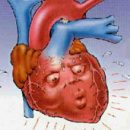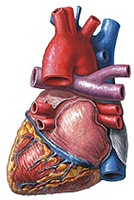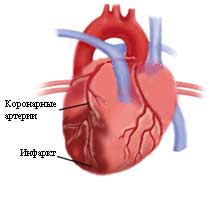What is the heart disease in the tetrade Fallo, transposition of the main arteries, anomalous drainage of pulmonary veins, which operations are necessary and what results should be expected? Read in this article.
Content
With vices accompanied by cyanosis, arterial blood flowing through the body contains less oxygen than normal. At the same time, the skin acquires a blue shade, that is, cyanosis arises. If cyanosis is moderate, then it looks like «rosy cheeks». If the cyanosis is heavy, the skin is painted in dark blue. The severity of the cyanosis may vary with age, with physical activity.
Tetrad Fallo
Tetrad Fallo includes 4 components.
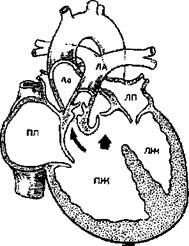 The first and most important — Defect of the interventricular partition. This is a large hole between two ventricles, allowing the blue venous blood to get from the right ventricle to the left. From there she enters the aorta and then diverges through the body, not falling into the lungs to be saturated with oxygen.The second important component of the Tetrad Fallo — Stenosis (narrowing) of a pulmonary artery valve or a sublined space. Narrowing limits blood flow in the lungs. The severity of this stenosis differs from different children.Two other components of the tetrades are: the walls of the right ventricle are much thicker than normal, and the aorta is located directly over the defect of the interventricular partition.
The first and most important — Defect of the interventricular partition. This is a large hole between two ventricles, allowing the blue venous blood to get from the right ventricle to the left. From there she enters the aorta and then diverges through the body, not falling into the lungs to be saturated with oxygen.The second important component of the Tetrad Fallo — Stenosis (narrowing) of a pulmonary artery valve or a sublined space. Narrowing limits blood flow in the lungs. The severity of this stenosis differs from different children.Two other components of the tetrades are: the walls of the right ventricle are much thicker than normal, and the aorta is located directly over the defect of the interventricular partition.
All together it causes cyanosis immediately after birth or later in childhood. Such cyanotic children can sometimes occur attacks with rapid breathing, or with loss of consciousness. Elder children during exercise may not have enough respiration, which leads to a fainted states. This is due to the fact that as a result of the restriction of blood flow into the lungs, the increased needs of the body in oxygen are not fully satisfied.
Surgery.Some children with a heavy form of Tetrad Fallo need an operation that brings them temporary relief (palliative operation), increasing blood flow in the lungs. This procedure is to create a message between the aorta and the pulmonary artery. Thus, a part of the blood from the aorta enters the lungs and, therefore, the amount of blood saturated with oxygen increases. It reduces cyanosis and allows the child to grow and develop until the radical correction of vice can be made.
Radical operation includes the closure of the defect of the interventricular septum and the removal of the portions of myocardium, which sighting the mouth of the pulmonary artery. If the pulmonary valve is narrowed, it is discovered, and if it is underdeveloped, the prosthesis is sewn or the patch is superimposed to complete the correction. A distant forecast after operation differs significantly from the patient to the patient. It is usually a good, but largely depends on the severity of the vice before the operation, especially from the severity of the narrowing of the pulmonary artery. In order to be sure that heart disease is completely eliminated and neatly, it is necessary for a long postoperative observation.
Transposition of the main arteries (TMA)
Normally in the pulmonary artery proceeds venous blood from the right ventricle into the lungs for gas exchange. On the aorta saturated with oxygen alaty blood from the left ventricle is spread over the body. When transposeing the trunk arteries, they change places. Aorta is connected to the right ventricle, so venous blood is dealt with the body. Pulmonary artery is connected to the left ventricle, that is, the lungs come again a sharp blood enriched with oxygen.
Children with transposition can only live if they have one or more blood blending paths between two circles of blood circulation. Such paths can be holes between the atria (defect of the interpresentation partition), between the ventricles (the interventricular septum defect), or the vessel connecting the pulmonary artery with the aorta (open arterial duct). Most children with the transposition of the main arteries are shortly after birth become bluish, because these ways of mixing the scarlet and blue blood are not adequate.
Treatment only surgical.In order for the child to survive, you need to improve the body's supply of oxygen. Produce balloon atrial septoostomy. This procedure increases the hole in the inter-subsensudual partition and facilitates the state of children, reducing cyanosis, allows you to grow to radical correction of vice.
Two main types of operations can be offered to correct this complex vice.
First type — the creation of tunnels inside the atrium, which guide the arterial alway blood into the right ventricle and aorta, and venous, blue — In the left ventricle and the pulmonary artery. This operation is called venous switching or in-sub-subsession procedure by changing the direction of blood flow. According to the names of surgeons, first who performed it, it may be called the Mastard procedure, or the Singling procedure. Terms of operation depend on many factors: for example, from the severity of the cyanosis.
During operation of another type, it is changed by places of artery. The aorta is connected to the left ventricle, after which it proceeds to the body to organ them, and the pulmonary artery — with right ventricle, which allows it to carry the venous blue blood in the lungs. This permutation procedure can be made during the first weeks of life or, depending on the conditions, a little later. If the dimensions of the confcturation of the interventory partition are large or there are other serious defects associated with the transposition, the correction of the vice is noticeably complicated. There are several options for a remote forecast after operations. They depend on the severity of the vice before the operation. It is necessary to carefully monitor the child in a long time after surgery, since doctors must be sure that the problems remaining after surgery are solved correctly.
Abnormal drainage of pulmonary veins
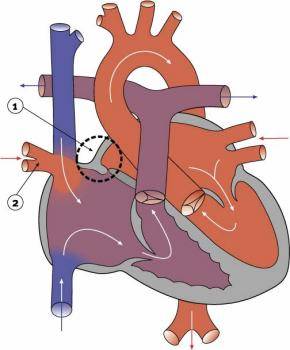 With anomalous drainage (shift) of the pulmonary veins, the last bonds carrying blood enriched with oxygen, from the lungs to the heart, are not connected to the left atrium. Instead, due to an abnormal compound, pulmonary veins are boring in the right atria. Anomalous drainage can be complete - when all pulmonary veins fall into the wrong, and partial-when one or more (but not all) veins fall abnormally.
With anomalous drainage (shift) of the pulmonary veins, the last bonds carrying blood enriched with oxygen, from the lungs to the heart, are not connected to the left atrium. Instead, due to an abnormal compound, pulmonary veins are boring in the right atria. Anomalous drainage can be complete - when all pulmonary veins fall into the wrong, and partial-when one or more (but not all) veins fall abnormally.
In the right of atrium, allay blood from pulmonary veins is mixed with blue, venous body. Part of the mixed blood passes through the defect of the interpidential partition in the left atrium. From there she enters the left ventricle, then in the aorta and spread over the body. Part of the mixed blood enters the right ventricle, then into the pulmonary artery and in the lungs. Blood, which aorta spreads through the body, contains insufficient oxygen, which causes the baby's sinusiness. Symptoms may appear shortly after birth.
Surgery.Total (full) Anomalous drainage of pulmonary veins must be corrected in early childhood. With partial drainage, the operation can be postponed. In the process of operation, pulmonary veins are connected to the left atrium and close the defect of the interpidential partition. Remote forecast after surgery can be very good. Nevertheless, it is necessary to monitor the child to be sure that possible complications, such as the narrowing of pulmonary veins or rhythm disturbances, will be eliminated accurately and timely.
Other complex anomalies
There are also other complex heart defects found quite rarely. One of them — The absence of one of the two ventricles (the only ventricle). With a different vice, pulmonary artery and aorta depart from one ventricle (double exit of the arteries from the ventricle), and not from two different. Sometimes the left or right half of the heart may be not well developed (gastroincing and atrium hypoplasia). In some cases, a child can immediately have several severe heart defects — Comprehensive cardiac anomaly.
Often complex cardiac vices cannot be corrected as a result of a single operation. Therefore, their elimination is produced in several stages. If your child has a complex heart disease, the cardiac surgery will explain what it is and what are the ways to eliminate possible elimination.


